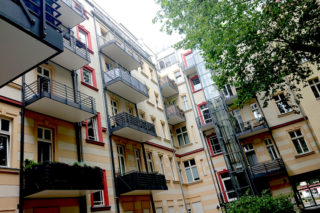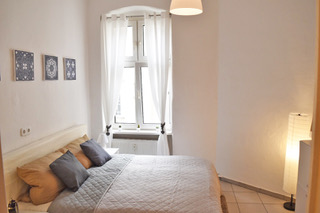2019-08-02 | Berlin’s Social Conservation Areas: protecting character or preserving poverty?
Berlin’s Social Conservation Areas: protecting character or preserving poverty?
Berlin, 02.08.2019 - Berlin has been in the international news most recently following the announcement by the Berlin Senate that it plans to introduce a law to freeze rents in the city for the next five years.
Much less publicity has been given to the further extension of “Social Conservation Areas” – also often referred to as Milieuschutz - earlier this year, which we believe will have as big a potential impact on the Berlin property market. We explain why here.
What are Social Conservation Areas?
Unlike the concept of conservation areas that anyone from the UK may be familiar with – dealing mainly with enhancing the physical appearance and fabric of the built environment – → Social Conservation Areas are also concerned with what happens inside the buildings.
There are now → 58 different areas of the city covered by these regulations, which are administered by the local district authorities. They cover not just the expected central areas of Mitte, Charlottenburg, Kreuzberg and Friedrichshain, but also stretch out into some rather unexpected more outlying areas including parts of Kopenick and Reinickendorf for instance.
The stated aim of these regulations is to protect the composition of the local residential population and have been around in Berlin since the mid-1990’s. As with the rent cap and proposed rent freeze, they are designed to avoid the loss of affordable housing and population displacement, but from what we see working with tenants, property owners and prospective buyers, they also appear to be having the effect of preserving poverty housing conditions and killing off social mobility.
A changing definition of “luxury”
One of the main stated aims of the regulations is to push back against what the city describes as “luxury modernisations” and “housing mergers” (i.e.: joining two small apartments that are next to each other together to make a larger one), but looking at what exactly is regarded as luxury in more detail is worth some time.
At the turn of the 20th century when many of the now highly desirable classic Berlin Altbau houses were built, having an internal bathroom and toilet in your apartment was a luxury. Visiting such buildings today you often see what were shared toilets on the communal landings now being used as storage cupboards, or ones outside in the internal courtyards as bicycle sheds. Over the following decades as standards and expectations changed, many of these apartments sacrificed part of their already limited space (many just two rooms to begin with) to create what still look like pretty cramped and basic facilities by todays standards.
Today the demands made on a modern home have moved on again, but in Berlin there appears to be a resistance to allowing the housing stock to catch up. The resident of a normal new-build development going up in Berlin will enjoy such features as triple-glazed windows, under floor heating, elevators and balconies, but the Berlin Senate has decreed that these facilities are too good for those living in old housing stock in protected areas. Having a second bathroom or guest WC in a larger apartment is also a no-go.
If balconies were good enough for citizens of the DDR…
In post-war Berlin there was something of a competition between the East and West zones in coming up with mass housing solutions for its citizens, much of which took forward the work of the Berlin Modernists in the 1930’s which can still be seen dotted around the city. The culmination of this was the 1957 Interbau exhibition, with the → Hansaviertel in the west acting as a showpiece development to rival Karl-Marx-Allee in the east.
Even through to the 1970’s and 80’s, as East Berlin expanded with mass housing developments into areas such as → Marzahn, mass housing for the citizens of the DDR still featured facilities such as balconies and elevators (the second being essential for higher-density buildings) and well-cut generous floor plans, even if by that time building quality and materials had been eroded.
In the decades following reunification, many older style properties had elements such as balconies and elevators retro-fitted – the former providing some welcome additional outside space in buildings that otherwise only have small inner courtyards, and the latter proving step-free access to upper-floors to older residents while opening-up under-used roof spaces for further residential space.


An invasion of personal space
As has been hinted at already, → Milieuschutz is not just about what happens on the outside of properties, but very much what happens on the inside too.
The regulations go well beyond the ability to refuse the merger of two existing (and often cramped or badly laid-out) apartments into one. They also prohibit changing existing floor plans within a unit that changes the number of rooms or living space. This means that creating an open-plan kitchen in a larger living room (a very standard thing today) in order to free up the kitchen for use as a bedroom, for instance, is not acceptable.
Alongside second bathrooms, the installation of fitted kitchens, fireplaces and even video intercoms can be rejected. Add all these things together and these regulations effectively lock-in poor housing design and standards for the current and next generation of Berlin residents.
Should you be buying property in Milieuschutz areas?
What all these regulations are really about in the end is holding rents down to levels that are only sustainable by maintaining poor housing conditions. Like rent caps and freezes, they do not deal with the structural issues of too few new apartments being built or too few properly paid jobs being available in the city.
Like with these other regulations, if you are thinking of buying an apartment in Berlin, you need to be aware of their implications so you can make an informed judgment about your purchase – whether for investment or as somewhere to live in yourself. If you are unclear whether a property you are interested in falls within one of the current or prospective protected areas you should ask – or you can also check for yourself.
If you find the perfect home for yourself or the perfect investment property in one of these areas, are happy with the current floor plan and facilities, the access and outside space, then that is great. If you want somewhere you can change, update or adapt to your future needs, then these regulations are another reason you should be widening your search to some areas in Berlin you may not yet be so familiar with. We will be happy to show you around.


